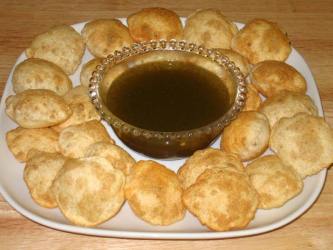Panipuri

The Panipuri is a popular street snack in India, Pakistan, Bangladesh, and
Nepal. It consists of a round, hollow puri, fried crisp and filled with a
mixture of flavored water ("pani"), tamarind chutney, chili, chaat masala,
potato, onion and chickpeas. It is generally small enough to fit completely
into one's mouth. It is a popular street food dish in Mumbai, Delhi, Lucknow,
Karachi, Lahore, Dhaka, Kolkata and Kathmandu.
In North India it is known as Gol Gappa. The name 'gol gappa' refers to the
crisp sphere (gol) that is placed in the mouth and eaten (gappa) one at a
time. Pani comes from the Hindi word for water and puri (or poori) is the
name of an Indian bread made by deep frying in oil. Dogras, Kashmiris,
Bhaderwahis, Gujjars, Paharis, Ladakhis, Himachalis of North India called it
"Gol Gappa'.
It is known as bataasha in the Western region of Uttar Pradesh. Bataasha is
something which gets smashed with application of a slight pressure; the
bataasha gets smashed as soon as it is placed inside the mouth. It is known
as Puchka in Eastern Indian states like Bihar, Jharkhand and West Bengal,
also in Bangladesh. Because of the bursting sound in the mouth when it is
eaten, called gup chup in Odisha, Hyderabad and South Jharkhand. Gol-Gappa
or Pani Pataase in Madhya Pradesh, Gup-Chup or Gol-Gappa or Panipuri in
Chhattisgarh. In several parts of Gujarat and Kutch. It is commonly known as
pakodi, not to be confused with pakoda.
History
The panipuri originated from the Magadha region of India, present day South
Bihar where it is also known as phulki. The English meaning of golgappa is
"watery bread" or "crisp sphere eaten." The literal meaning suggests that it
may have originated from Varanasi. In Bengal and specifically Kolkata,
Puchka is considered to be the king of this variety of snacks, compared to
its cousins like golgappas or panipuris. The filling is made by lightly
mashing boiled potatoes with black salt, salt, some spices, a generous
portion of tamarind pulp (made by mashing ripe tamarind in tamarind water),
chilli (powder/chopped/boiled & pasted). The tamarind water Tetul Jol is
made by mixing tamarind and spices/ salt and making a light and tart liquid
with water. At some places like Deshpriya Park, a very famous variety is
made with sour curd, and called Dahi (curd) Puchka.
Serving
Typically, 4 - 8 panipuris are served over a portion on a triangular plate
made from dry sal leaves. Some places offer panipuris prepared on a whole
plate, but the popular way for them to be served is one-at-a-time from a
roadside vendor. Customers hold a small plate or bowl (katori) and stand
around the vendors cart. The server then starts making one panipuri at a
time and gives one to each individual. Panipuri servers have to remember
each customer's preferences such as sweetened pani, more filling or extra
onions, for example. The server must keep count of how many panipuris each
person has had.
Traditionally, panipuris are eaten by placing the entire puri into the mouth
in one go and biting into it. This releases a barrage of tastes and
textures. Panipuris may be finished off with a cup of the pani, sweetened or
made tarter to taste.
Sources: Wikipedia
undo ...back